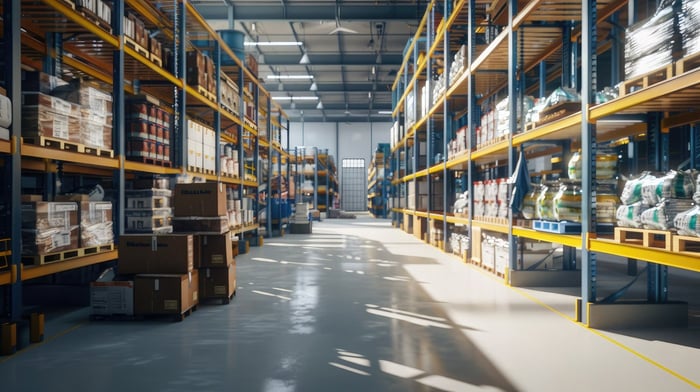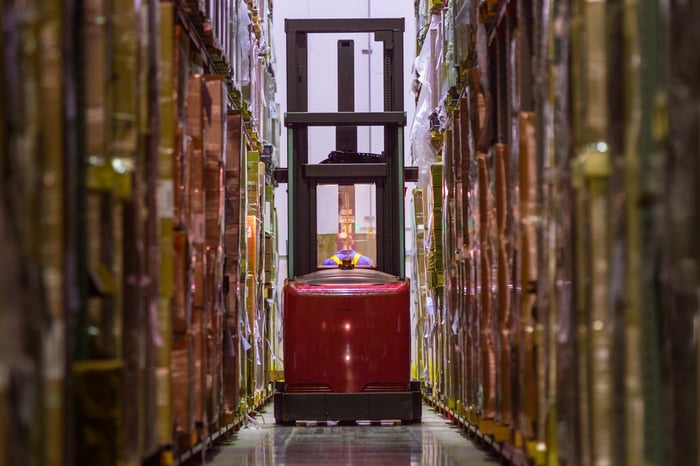Shelf-supported mezzanines are taking over warehouses from coast to coast for good reason. They offer operators a number of advantages and support high-density storage inventories, maximizing space and efficiency overall.
Do these benefits sound like something your warehouse could use? Then this is the guide for you. Keep reading as we dive deep into warehouse mezzanines. We’ll cover the in-depth benefits of implementing the style, the various types, and how to install one in your warehouse.
So, keep reading to learn everything you need about shelf-supported mezzanines and more.
What is a Warehouse Mezzanine?
Using some support or standard components, units are constructed with an open “deck-over” upper level for additional shelves. This inventory design allows more storage to be kept in a smaller area. Shelves that support the raised level can also store inventory, making them multifunctional (and space-efficient!)
By building storage vertically, warehouse operators can have a more concentrated space for shelving and organizing parts, tools, or inventory.
Where You’ll Find Warehouse Mezzanines
Due to their versatile nature, shelf-supported mezzanine structures are found in a variety of industries, including:
-
Distribution Centers: These facilities use mezzanines to enhance order fulfillment processes, creating space for sorting, packing, and shipping areas, as well as additional storage.
-
Manufacturing Warehouses: In manufacturing environments, theyprovide additional space for production lines, equipment storage, and quality control areas, helping to streamline operations.
-
Retail Warehouses: Retailers use these structures to store excess inventory, display seasonal items, or create office space for administrative functions, optimizing the use of their facilities.
-
E-commerce Fulfillment Centers: Mezzanines in e-commerce warehouses help manage the high volume of small package orders by providing space for packing stations, returns processing, and product storage.
-
Cold Storage Facilities: These warehouses use them to store non-perishable items or for administrative areas, keeping the ground floor reserved for temperature-sensitive goods.
-
Automotive Parts Warehouses: Mezzanines offer space for organizing and storing various automotive parts, making managing inventory easier and streamlining order processing.
-
Pharmaceutical Warehouses: In pharmaceutical facilities, they can be used for additional storage of medical supplies, equipment, or even office spaces while maintaining strict regulatory compliance.
-
Food and Beverage Warehouses: Mezzanines are useful in these warehouses for storing packaging materials and non-perishable items or creating separate areas for different processing stages.
-
Third-Party Logistics (3PL) Warehouses: 3PL providers often use them to increase storage capacity and create flexible spaces for different clients' needs, such as dedicated areas for specific customers.
Cannabis cultivation and processing operations are also new, and common facilities are using mezzanine structures to gain benefits for production.
Types of Mezzanine Structures
There’s no one-size-fits-all regarding warehouse design, but knowing the type of mezzanine structure best suited for your operation will help engineer its specific layout. Here are the most common types to know:
-
Shelf-supported mezzanines: Instead of typical structural supports, this type of mezzanine structure uses actual shelves to build the upper deck or vertical level. Therefore, storage space is maximized since the supports are storage areas themselves.
-
Catwalk mezzanines: These elevated platforms, appropriately named catwalks for their fashion show-like appearance, allow for free traffic flow and more usable traffic lanes for workers.
-
Freestanding mezzanines: As described, freestanding mezzanines add structural columns to existing components to create supports.
If you’re unsure what type of mezzanine structure is for you, a professional can help you determine which is, and in general, shelf-supported mezzanines are some of the most common.
Benefits of Mezzanines in Warehouses
These types of strcutures are growing in popularity for the benefits they provide operators. Of course, the benefits will vary depending on the warehouse type and the mezzanine structure application. In general, however, here are some benefits that you can expect.
Additional Storage
Mezzanines, and especially shelf-supported mezzanines provide ample space for warehouse operators to hold and store additional inventory. This alleviates the common issue for distribution centers, manufacturing facilities, and other warehouses, which quickly outgrow their spaces.
Avoid Relocation
Speaking of storage problems and constraints, many operators must consider relocating their warehouse when these issues arise. However, this investment is often too much to take on. By gaining additional storage and reconfiguring specific processes, your operation can reconsider relocating and avoid downtime during the move.
Optimize Space
Look up in your warehouse and consider all the unused space vertically. Mezzanines in warehouses help put this unused space to good use, maximizing your space. So, what are some things you can do with your new-found space?
-
Expand shelving
-
Add more racking systems
-
Use the platform for office space
-
Utilize the mezzanine for observations or floor management
-
Expand shelving or racking systems
The best thing about mezzanine structures is you can use them however best suited for your business.
Cost Efficiency
Installing a mezzanine is a more affordable way to increase space than constructing a new building or expanding existing facilities.
Even more, by providing additional space for organizing inventory, separating different types of products, or creating dedicated work areas, you can enhance your operation’s productivity and workflow, increasing profits.
Ease of Installation
Compared to full-scale construction projects, mezzanines can be installed relatively quickly, minimizing disruption to operations. They are also highly flexible and can be customized and modified as needed. Allowing businesses to adapt the space to changing needs or future growth.
How to Install a Warehouse Mezzanine
Installing a mezzanine in a warehouse involves several key steps to ensure safety and efficiency. Here’s a general overview of what to expect.
-
First, assess the space and determine the mezzanine's desired size and load capacity.
-
Next, necessary permits will be obtained to ensure compliance with local building codes.
-
Once approved, prepare the site by clearing the area and marking the floor for the mezzanine's footprint.
-
Install the support columns by anchoring them securely to the floor, ensuring they are level and plumb.
-
Then, attach the beams to the columns, creating the frame for the mezzanine floor.
-
Depending on the design, install the flooring, typically using steel decking or wood panels.
-
Finally, railings and stairs should be added for safety and accessibility.
-
Before using the mezzanine, conduct a thorough inspection after installation to ensure all components are secure and meet safety standards.
Of course, it pays to hire a professional to assess your warehouse's efficiency and design an engineered layout that’s best suited for your operation. Professional warehouse suppliers and service providers will take care of the process step-by-step and help keep your operations running while doing so, too.
The Bottom Line: Warehouse Mezzanines
Whether you decide on a shelf-supported mezzanine or a different type, a professional specialist is a must. This helps your warehouse benefit from mezzanines specifically suited to your inventory or operations.
At BMH, our engineered layouts ensure every aspect of the build is considered and that the design selected powers your operation for success.
Explore BMH products, like pallet racks and shelving, or the services we offer warehouse operators. Find a BMH location near you now, or get in touch or tap into additional resources to learn more.




